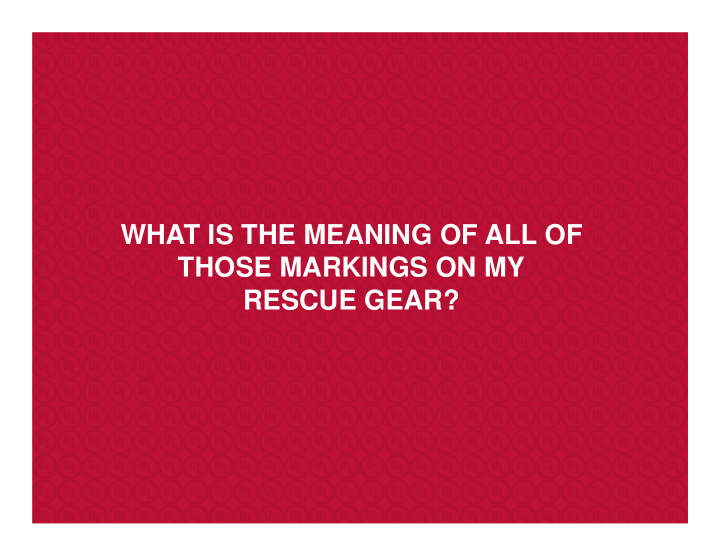



WHAT IS THE MEANING OF ALL OF THOSE MARKINGS ON MY RESCUE GEAR?
Beverly Wooten Stutts G.W. Barrett of UL And Who Are We?
WORKING FOR A SAFER WORLD SINCE 1894 “Know by test, and state the facts…” UL Founder, William Henry Merrill 3 3
What UL Does for Today’s Challenges TESTING INSPECTION CERTIFICATION AUDITING VALIDATION 4
Different Standards for Fall Protection and other Technical Rescue • NFPA 1983 – Standard on Life Safety Rope and Equipment for Emergency Services . NFPA 1983 includes: • Rope and Webbing Products • Harnesses and Belts • Straps • Victim Extrication Devices • Various Hardware 5
Different Standards for Fall Protection and other Technical Rescue • NFPA 1983 – Standard on Life Safety Rope and Equipment for Emergency Services . NFPA 1983 also includes: • Escape Systems • Fire Escape Systems • Manufactured Systems NFPA 1983 Hardware includes: • Tripods (portable anchors) • Escape Hooks (escape anchors) • Carabiners • Pulleys • Litters • Descent Control Devices • Belay Devices • Ascending Devices and Rope Grabs • Rigging Plates 6
Different Standards for Fall Protection and other Technical Rescue • ANSI/ASSE Z359 Fall Protection • CSA Z259 Fall Protection • EN standards for Fall Protection • Numerous ASTM Standards • Cordage Institute 7
Other Technical Rescue Standards • NFPA 1951 – Standard on Protective Ensembles for Technical Rescue Incidents • NFPA 1952 – Standard on Surface Water Operations Protective Clothing and Equipment • NFPA 1953 – Standard on Protective Ensembles for Contaminated Water Diving 8
Why Have Standards?
What is Standardized Testing? • Means to test fall protection products or systems consistently • Tests are Repeatable and Reproducible • Test to the same criteria • With the same interpretations • With the same reporting and presentation
Value of Standardized Testing • Means for straight comparison • Predictable • Not lab dependent • International • Ability to demonstrate compliance to codes and specifications • Applies to performance based design to set baseline • And more… 11
Value of Standardized Testing (cont’d) • Identification of failure modes • Provides documented performance and can be used to measure product performance through its evolution • Standardized test reports 12
Certification by Third Party Certification Organizations
Importance of Third Party Certification Organizations • Provide non-bias testing and certification information • Third Party Certification required by certain standards • Certain municipalities or organizations may require equipment to be certified • Certification includes follow-up service • These organizations are audited both internally and externally for compliance to test methods, calibration of equipment, training of staff • Reinforces integrity of the product 14
What is Follow-Up, Annual Recertification, Verification…. Once a product is certified, the certification organization conducts ongoing surveillance to make sure that there is: CONTINUED COMPLIANCE OF PRODUCT 15
Demand Drivers for Third Party Certification • Standard Requirement • Authority Having Jurisdiction (AHJ) • Insurance companies • Specifiers
What About Third Party Laboratories for Testing – but not Certification?
Role of Independent Third Party Laboratories Provide non-biased testing If ISO 17025 accredited laboratory, subjected to some of same audits as third party certification organization Provide the manufacturer with test report with all test data No ongoing surveillance
Performance Markings
Class of Use G = General Use
Class of Use G = General Use T = Technical Use E = Escape Use
Minimum Breaking Strength MBS ANSI/CSA Minimum Breaking Strength 22
Compliance Statement and Certification Organization “MEETS NFPA 1983(2012)” 23
Additional Information on Product Range of Rope Diameters for the Device Name or Logo of Manufacturer Standard Number Year of Manufacture and Lot Number Capacity Rating 24
Paper Labels Manufacturer’s name or Logo Manufacturer’s Address Manufacturer’s Product ID Model, Style, Lot, or Serial Number Country of Manufacture 25
Paper Labels continued Compliance Statement required “MEETS LITTER REQUIREMENTS OF NFPA 1983, STANDARD ON LIFE SAFETY ROPE AND EQUIPMENT FOR EMERGENCY SERVICES” “EMERGENCY SERVICES LITTER IN ACCORDANCE WITH NFPA 1983-2012” 26
Paper Labels continued Additional Warning Statements “MINIMUM BREAKING STRENGTH AND RATING ARE DETERMINED AT THE CONFIGURATION OF LOWEST STRENGTH PER MANUFACTURER’S INSTRUCTIONS” Materials of Construction % Elongations at Specified Loads Additional MBS Values 27
User Information
User Information Proper Use Suggestions for Record Keeping Misuse Storage Limitations of Equipment Repair Disposal Installation Instructions Ropes tested with device for Maintenance Procedures NFPA descent control device Inspection Frequency and Procedures
Online Certification Directories
www.ul.com 31
32
33
34
35
36
37
38
39
40
41
42
43
44
45
Questions?
Recommend
More recommend